According to a lecture given by C.S.R. Prabhu, senior scientist, NIC, Hyderabad, India had access to advanced warfare technology that was far beyond the capabilities of the West. He argued that the ancient texts Brahmastra and Vimana were early versions of modern nuclear weapons and spacecraft. During the pre-Mahabharata period, there were remarkable technological advancements that were neglected during the medieval period for reasons not yet known. Sastry's texts, dictated in yogic trance, contained technical details on how to assemble, fabricate and erect a spacecraft, and the metals, semiconductors and advanced alloys used, including other minute aeronautical information. Although difficult to believe, the fact that this technology did not exist in the world, not even in America or Europe, during that period makes it hard to disbelieve.
The spacecraft could even become invisible by using a lead alloy called Thamogarbha loha, which would absorb light in a photochemical reaction that would make it disappear. To reinforce his argument, Prabhu mentioned that wall paintings in some forts in Rajasthan depict the use of rockets in Mughal warfare, including by Tipu Sultan of Mysore. The spacecraft's body was made with a metal called Raja Loha, which apart from resisting heat, converted light from lightnings into energy. Prabhu noted that though the texts explained that the spacecraft was propelled by 'Sourasakthi,' modern solar technology does not generate enough power to drag a rocket, but it was a type of nuclear power that was used during that time.
The Ararakamra metal was an alloy of copper, zinc, lead, and iron, which is impossible according to modern metallurgy. The Young's modulus of the metal was higher than that of steel, making it stronger. The axle and wheels used Ararakamra material, which allowed the spacecraft to take U-turns and serpentine movements. Prabhu submitted the model and some information on the "super metal" to the Indian Metal Society Conference and claimed that Dr. A. P. J. Abdul Kalam, the advisor to the government on scientific affairs, asked him to bring the design of the plane.
The Indian Institute of Science appointed a committee to investigate the claims but declared Sastry's texts as fraud, possibly due to the descriptions mentioned in the ancient texts being too advanced to believe. Prabhu proposed a project called 'Bharadwaja Institute of Vedic Science' to investigate the so-called 'myths' as scientific formulae on advanced technology. Although this theory is controversial, Prabhu believes in the authenticity of these ancient texts and hopes that future research will help to uncover the truth.
Vimanas: Ancient Indian Flying Machines
The Vedas, some of the oldest Indian texts, describe Vimanas as flying machines with various shapes and sizes. These machines were known for their impressive abilities and were used as weapons of war. The Asvins, the Atlanteans in Indian texts, had more advanced technology than the Indian people, and their "Vailixi" flying machines had a cigar-like shape that allowed them to maneuver both underwater and in outer space.The ancient guide to Vimanas, Yantra Sarvasva, describes three classes of Vimana based on their range. Some were made to travel locally from one place to another, while others were used to travel to different countries. The third class of Vimanas was used to travel to various planets. Vimanas were non-combustible, unbreakable, and invisible to enemies. They were just as effective on the offensive, able to render enemies into a suspended animation state and cause widespread destruction.
In the ancient Hindu texts, the empire of Rama existed nearly fifteen thousand years ago during the time of the Atlantean civilization, ruled by Priest-Kings. The empire had seven cities, and the people of the Seven Rishi cities had flying machines named Vimanas. There are four types of Vimanas described in the text, some of which were saucer-shaped, while others were cylinder-shaped. These flying machines had circular aircraft with portholes over two decks and a dome. A Vimana is described as flying with the wind’s speed and producing a melodious sound.
The ancient Indians who created these ships also wrote flying manuals about the controls of several Vimana types. Many of these manuals are still in existence and offer a detailed guide for piloting these craft.
The descriptions of Vimanas in ancient Indian texts and epics provide fascinating insights into the technological advancements of the time. These flying machines were not merely a figment of imagination, but were believed to be real and functional, with detailed instructions on their operation and control. While some may dismiss these accounts as mythical or exaggerated, others believe that they offer evidence of ancient civilizations' technological sophistication. Regardless of one's perspective, the Vimanas' descriptions are a testament to the creativity and imagination of the people of ancient India and offer a glimpse into their culture and beliefs.
Articles you might like:




No comments:
Post a Comment